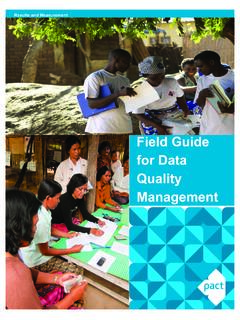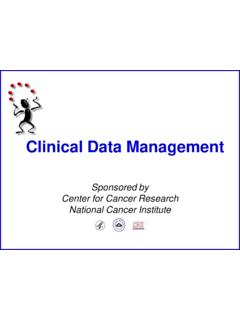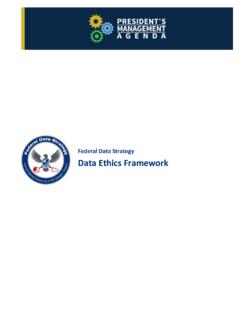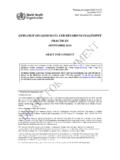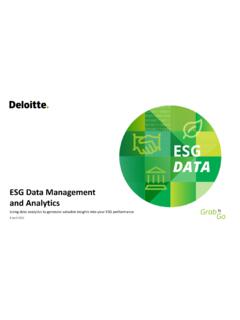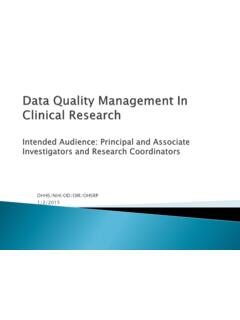Transcription of GOOD PRACTICES FOR DATA MANAGEMENT AND …
1 PI 041-1 (Draft 3) 1 of 52 30 November 2018 PHARMACEUTICAL INSPECTION CONVENTION PHARMACEUTICAL INSPECTION CO-OPERATION SCHEME 1 PI 041-1 (Draft 3) 2 30 November 2018 3 4 5 6 7 8 9 PIC/S GUIDANCE 10 11 12 13 14 GOOD PRACTICES FOR data MANAGEMENT AND INTEGRITY IN REGULATED GMP/GDP ENVIRONMENTS 15 16 17 18 19 20 21 PIC/S November 2018 Reproduction prohibited for commercial purposes. Reproduction for internal use is authorised, provided that the source is acknowledged. 22 23 24 25 26 Editor: PIC/S Secretariat e-mail: web site: 27 28 PI 041-1 (Draft 3) 2 of 52 30 November 2018 TABLE OF CONTENTS 29 Page 30 31 1. Document history .. 3 32 2. Introduction .. 3 33 3. Purpose .. 4 34 4. Scope .. 5 35 5. data governance system .. 5 36 What is data governance? .. 5 37 data governance systems .. 5 38 Risk MANAGEMENT approach to data 6 39 data criticality .. 7 40 data risk.
2 7 41 data governance system review .. 8 42 6. Organisational influences on successful data integrity MANAGEMENT .. 8 43 General .. 8 44 Code of ethics and policies .. 9 45 Quality culture .. 10 46 Modernising the Pharmaceutical Quality System .. 11 47 Regular MANAGEMENT review of quality metrics .. 11 48 Resource allocation .. 11 49 Dealing with data integrity issues found 12 50 7. General data integrity principles and enablers .. 12 51 8. Specific data integrity considerations for paper-based systems .. 14 52 Structure of the QMS and control of blank forms/templates/records .. 14 53 Importance of controlling records .. 15 54 Generation, distribution and control of template records .. 15 55 Expectations for the generation, distribution and control of records .. 15 56 Use and control of records located at the point of use .. 18 57 Filling out records .. 18 58 Making corrections on records.
3 20 59 Verification of records (secondary checks) .. 20 60 Direct print-outs from electronic systems .. 22 61 True copies .. 22 62 Limitations of remote review of summary reports .. 23 63 Document retention .. 24 64 Disposal of original records .. 24 65 9. Specific data integrity considerations for computerised 25 66 Structure of QMS and control of computerised systems .. 25 67 Qualification and validation of computerised systems .. 26 68 System security for computerised systems .. 33 69 Audit trails for computerised systems .. 38 70 data capture/entry for computerised systems .. 40 71 Review of data within computerised systems .. 41 72 Storage, archival and disposal of electronic data .. 42 73 PI 041-1 (Draft 3) 3 of 52 30 November 2018 MANAGEMENT of Hybrid Systems .. 44 74 10. data integrity considerations for outsourced activities .. 45 75 General supply chain considerations .. 45 76 Routine document verification.
4 45 77 Strategies for assessing data integrity in the supply chain .. 46 78 11. Regulatory actions in response to data integrity findings .. 47 79 Deficiency references .. 47 80 Classification of 48 81 12. Remediation of data integrity failures .. 49 82 Responding to significant data integrity issues .. 49 83 Indicators of improvement .. 50 84 13. Definitions .. 51 85 14. Revision 52 86 87 88 1 DOCUMENT HISTORY 89 90 Adoption by Committee of PI 041-1 [Date] Entry into force of PI 041-1 [Date] 91 2 INTRODUCTION 92 PIC/S Participating Authorities regularly undertake inspections of manufacturers and 93 distributors of Active Pharmaceutical Ingredient (API) and medicinal products in 94 order to determine the level of compliance with Good Manufacturing Practice (GMP) 95 and Good Distribution Practice (GDP) principles. These inspections are commonly 96 performed on-site however may be performed through the remote or off-site 97 evaluation of documentary evidence, in which case the limitations of remote review 98 of data should be considered.
5 99 The effectiveness of these inspection processes is determined by the veracity of the 100 evidence provided to the inspector and ultimately the integrity of the underlying data . 101 It is critical to the inspection process that inspectors can determine and fully rely on 102 the accuracy and completeness of evidence and records presented to them. 103 Good data MANAGEMENT PRACTICES influence the quality of all data generated and 104 recorded by a manufacturer and these PRACTICES should ensure that data is 105 attributable, legible, contemporaneous, original, accurate, complete, consistent, 106 enduring, and available. While the main focus of this document is in relation to 107 GMP/GDP expectations, the principles herein should also be considered in the wider 108 context of good data MANAGEMENT such as, data included in the registration dossier 109 based on which API and drug product control strategies and specifications are set.
6 110 data Integrity is defined as the extent to which all data are complete, consistent and 111 accurate, throughout the data lifecycle 1 and is fundamental in a pharmaceutical 112 quality system which ensures that medicines are of the required quality. Poor data 113 integrity PRACTICES and vulnerabilities undermine the quality of records and evidence, 114 and may ultimately undermine the quality of medicinal products. 115 Good data MANAGEMENT PRACTICES apply to all elements of the pharmaceutical quality 116 system and the principles herein apply equally to data generated by electronic and 117 paper-based systems. 118 1 MHRA GMP data Integrity Definitions and Guidance for Industry March 2015 PI 041-1 (Draft 3) 4 of 52 30 November 2018 The responsibility for good PRACTICES regarding data MANAGEMENT and integrity lies 119 with the manufacturer or distributor undergoing inspection.
7 They have full 120 responsibility and a duty to assess their data MANAGEMENT systems for potential 121 vulnerabilities and take steps to design and implement good data governance 122 PRACTICES to ensure data integrity is maintained. 123 124 3 PURPOSE 125 This document was written with the aim of: 126 Providing guidance for inspectorates in the interpretation of GMP/GDP requirements 127 in relation to good data MANAGEMENT and the conduct of inspections. 128 Providing consolidated, illustrative guidance on risk-based control strategies which 129 enable the existing requirements for data integrity and reliability as described in 130 PIC/S Guides for GMP2 and GDP3 to be implemented in the context of modern 131 industry PRACTICES and globalised supply chains. 132 Facilitating the effective implementation of good data MANAGEMENT elements into the 133 routine planning and conduct of GMP/GDP inspections; to provide a tool to 134 harmonise GMP/GDP inspections and to ensure the quality of inspections with 135 regards to data integrity expectations.
8 136 This guidance, together with inspectorate resources such as aide memoire, should 137 enable the inspector to make an optimal use of the inspection time and an optimal 138 evaluation of data integrity elements during an inspection. 139 Guidance herein should assist the inspectorate in planning a risk-based inspection 140 relating to good data MANAGEMENT PRACTICES . 141 Good data MANAGEMENT has always been considered an integral part of GMP/GDP. 142 Hence, this guide is not intended to impose additional regulatory burden upon 143 regulated entities, rather it is intended to provide guidance on the interpretation of 144 existing GMP/GDP requirements relating to current industry data MANAGEMENT 145 PRACTICES . 146 The principles of data MANAGEMENT and integrity apply equally to paper-based, 147 computerised and hybrid systems and should not place any restraint upon the 148 development or adoption of new concepts or technologies.
9 In accordance with ICH 149 Q10 principles, this guide should facilitate the adoption of innovative technologies 150 through continual improvement. 151 The term Pharmaceutical Quality System is predominantly used throughout this 152 document to denote the quality MANAGEMENT system used to manage and achieve 153 quality objectives. While the term Pharmaceutical Quality System is used 154 predominantly by GMP regulated entities, for the purposes of this guidance, it should 155 be regarded as interchangeable with the term Quality System used by GDP 156 regulated entities. 157 158 4 SCOPE 159 The guidance has been written to apply to on-site inspections of those sites 160 performing manufacturing (GMP) and distribution (GDP) activities. The principles 161 within this guide are applicable for all stages throughout the product lifecycle. The 162 guide should be considered as a non-exhaustive list of areas to be considered during 163 inspection.
10 164 The guidance also applies to remote (desktop) inspections of sites performing 165 manufacturing (GMP) and distribution (GDP) activities, although this will be limited 166 2 PIC/S PE 009 Guide to Good Manufacturing Practice for Medicinal Products, specifically Part I chapters 4, 5, 6, Part II chapters 5, 6 & Annex 11 3 PIC/S PE 011 Guide to Good Distribution Practice for Medicinal Products, specifically sections 3, 4, 5 & 6 PI 041-1 (Draft 3) 5 of 52 30 November 2018 to an assessment of data governance systems. On-site assessment is normally 167 required for data verification and evidence of operational compliance with 168 procedures. 169 Whilst this document has been written with the above scope, many principles 170 regarding good data MANAGEMENT PRACTICES described herein have applications for 171 other areas of the regulated pharmaceutical and healthcare industry.

